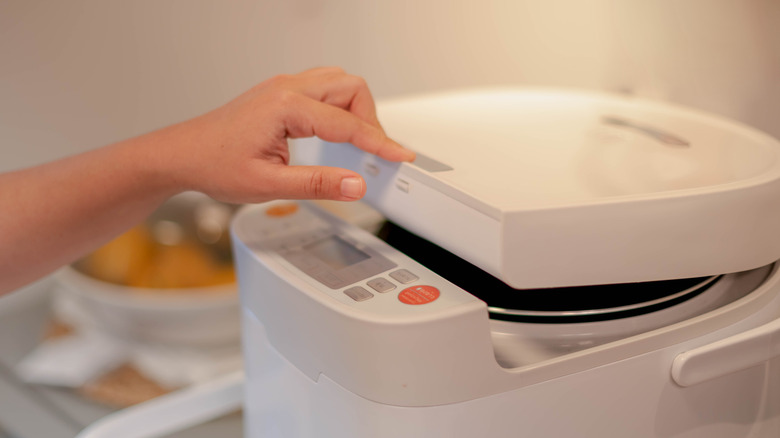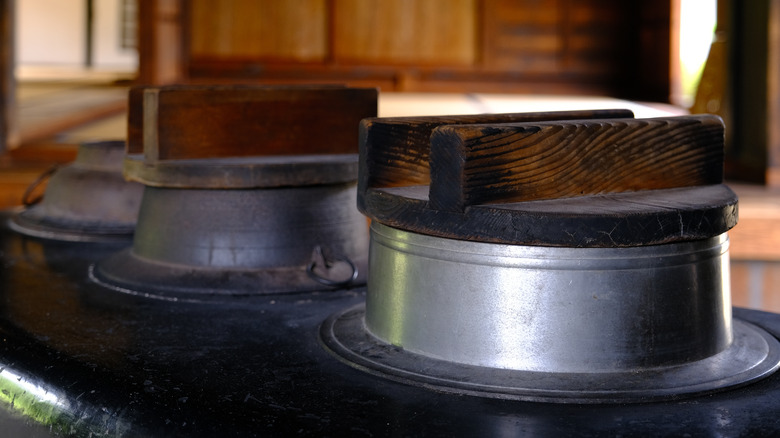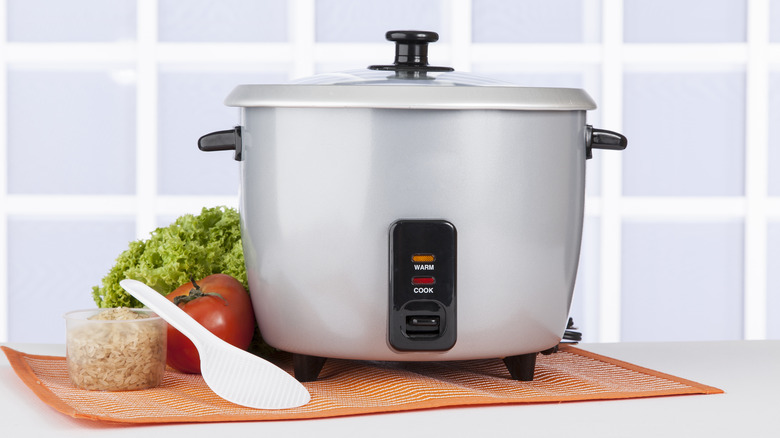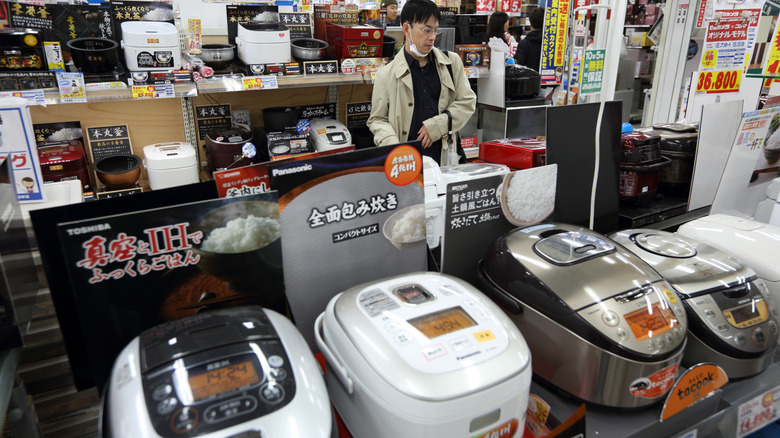Automatic Rice Cookers Are A More Recent Invention Than You Might Think
Those of us who have a rice cooker probably can't imagine what life might be like without it. After all, the versatile appliance doesn't just make rice and other grains, it can reheat leftovers, make cakes and rice puddings, steam dumplings, cook soups and pasta; it can even poach fruit, per Insider. In fact, rice cooker fans might even say that rice cookers were Instant Pots before Instant Pots were a thing.
And while we might think of rice cookers as an indispensable part of many kitchens today, it wasn't too long ago when rice had to be cooked over an open flame on a traditional wood-burning stove, known in Japan as a kamado, per Open Edition. Once a fire was started, a pot known as a kama was filled with grains and water and then placed on top of the kamado to cook, with the taste of the rice ultimately depending on how hot the flames were.
Web-Japan describes the process as one where the cook starts off with the pot set over a low flame, making the flame stronger at a point, and then decreasing the flame again when the rice pot "begins to bubble." This process was done over a naked flame, and with no way of managing heat control, it's no surprise housewives spent hours trying to get it right — and probably got frustrated along the way. Unfortunately, it took many years of trial and error for rice cooker technology to be as advanced as we see today.
Early rice cookers faced many challenges
Work on the first-ever electric rice cooker began in 1923 by an engineer at Mitsubishi Electric, and he came up with an industrial model that was used in ships and the Japanese military also used it in the field, per Atlas Obscura. According to Open Edition, early rice cookers were rounded on the sides but with a flat bottom, which helped keep them steady.
But Open Edition adds that the early rice cookers couldn't be called "cookers" because they just boiled water that would later be used to cook rice. These "rice cookers" also presented potential users with a unique set of challenges because they needed electricity and were difficult to clean.
There was another early rice cooker iteration — this one appeared in 1945, after the war, and was built by an engineer named Masaru Ibuka, who took wooden tubs and lined them with aluminum filaments. These contraptions were tested with rice grains obtained on the black market and — per Ibuka, they didn't work unless the rice grains were of good quality, so the rice ended up either too wet or too dry. Ibuka says he recalls "sitting there on the third floor in Shirokiya day after day being fed rice that wasn't fit to eat" and decided to go back to his original calling — fixing radios and building a company that would later be called "Sony" in the process.
The rice cooker is just over sixty years old
Sony's wooden rice cooker wouldn't be the last failed attempt to make an electric, automatic device that could cook rice to the Japanese homemaker's exacting specification. After all, rice cooked in a kado was still considered the gold standard that all households were expected to reach, but homemakers were desperate for a rice cooking option that would free them up to do other things, per Atlas Obscura.
In the early 1950s, a traveling salesman named Shogo Yamada — who worked with electronics firm Toshiba — decided to work with a water heater maker named Yoshitada Minami to develop a way to cook rice. Minami responded by pushing the task onto his wife, Fumiko, who began by looking at all the rice cookers that were available at the time. It was Fumiko that road-tested all the prototypes, working through all the problems that included a lack of proper insulation that would keep the pot hot, and the absence of a mechanism that could keep the temperature in the pot consistently at 212 degrees Fahrenheit, or the boiling point of water. Open Edition says it took the Minami's five years — from 1951 until 1956 — in order to get the technology right.
Today's rice cookers come in different models
At its most basic, a modern rice cooker is made up of a heating element (which easily brings the temperature up to the ideal 212 degrees Fahrenheit), a temperature sensor, and a metal bowl, which is meant to contain the uncooked rice and water, per CNET. For most rice cookers, the water-to-rice ratio is 2 to 1. As soon as the water starts to boil, the rice begins to cook and it absorbs all the water. When the water is gone, the temperature rises, triggering the temperature sensor which switches off the "cook" function of the machine.
Advances in microprocessing and induction heating (IH) have also allowed rice cooker manufacturers in Japan to make machines that can cook rice with the look and taste of rice cooked in a traditional kama — which still remains the gold standard, per Open Edition. One model made by Toshiba offers a rice cooker that can generate higher levels of heat, making the resulting rice sweeter or chewier. Another model offers a pot coated with iron, stainless steel, and aluminum and comes with a cooking system that allows an owner to adjust the temperature and cooking time to produce a variety of textures. But to get your hands on these Rolls Royce of rice cookers, you can expect to pay at least several hundred dollars.



